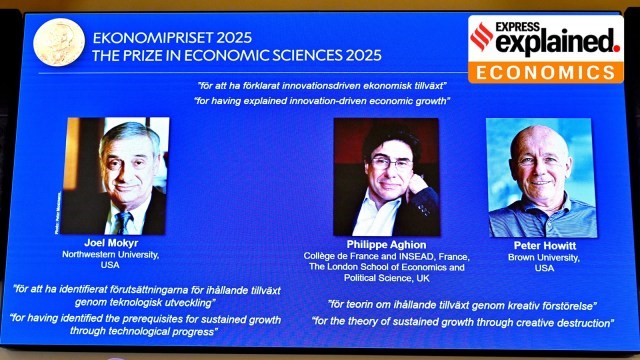2025 Nobel Prize in Economic Sciences: Understanding Innovation-Driven Growth

- 16 Oct 2025
In News:
The 2025 Nobel Prize in Economic Sciences has been awarded to Joel Mokyr, Philippe Aghion, and Peter Howitt for their seminal contributions to explaining how innovation drives long-term economic growth. Their work collectively answers a fundamental question in development economics: why has sustained growth become the norm in the last two centuries, despite millennia of stagnation? While Mokyr approaches the issue through economic history, Aghion and Howitt construct a formal model illustrating the dynamics of innovation and competition in modern economies.
Mokyr’s Framework: Useful Knowledge and Openness to Change
Joel Mokyr argues that economic stagnation persisted through most of human history because innovation lacked a strong scientific foundation. Prior to the Industrial Revolution, technological progress was primarily prescriptive—people knew how to produce goods but not why processes worked as they did. This limited systematic improvement.
The transformation began during the Scientific Revolution (16th–17th centuries) when controlled experimentation, measurement, and reproducibility became central to knowledge creation. This generated “useful knowledge”—a synergy of propositional (scientific principles) and prescriptive (practical techniques) knowledge. Examples include improvements in the steam engine driven by insights into atmospheric pressure and advancements in steel production based on understanding carbon reduction in iron.
However, knowledge alone was not sufficient. Societal openness to change, a hallmark of Enlightenment thought, enabled technological disruption. Acceptance of new ideas, weakening of entrenched elites, and institutional reforms—from the British Parliament curbing aristocratic privileges to society’s rejection of Luddite resistance to machinery—allowed innovations to diffuse widely. According to Mokyr, skills-based human capital and a culture supportive of disruption are crucial pillars of sustained growth.
Aghion–Howitt’s Creative Destruction Model
Drawing on Joseph Schumpeter’s concept of creative destruction, Aghion and Howitt develop a rigorous macroeconomic model explaining how innovation displaces old technologies and firms, generating productivity gains. Their model shows that firms invest in research and development (R&D) to secure temporary monopoly power through patents. This monopoly incentivizes innovation, yet it is continually threatened by newer technologies. Thus, growth emerges from a constant cycle of competition, firm turnover, and technological leaps.
Importantly, their general equilibrium framework links household savings, financial markets, production decisions, and innovation incentives, demonstrating that micro-level disruptions are essential for macro-level stability. Empirical trends—such as high annual firm entry and exit rates in developed economies—support their argument.
Policy Implications
The Nobel findings highlight key contemporary debates:
- R&D Subsidies: Innovation has positive spillovers beyond private profit. Public funding can correct under-investment, but excessive subsidies risk waste where gains are marginal.
- Social Safety Nets: Creative destruction benefits economies but harms displaced workers and firms. A balanced welfare ecosystem ensures societies remain open to technological change.
- Skilling and Human Capital: To convert ideas into output, governments must invest in education, vocational training, and research ecosystems.
Conclusion
The 2025 Nobel laureates collectively establish that economic growth is neither automatic nor guaranteed—it is the result of science-based knowledge creation, institutional openness, and dynamic competition. For emerging economies like India, fostering innovation-driven growth requires strong research systems, regulatory flexibility, investment in human capital, and social policies that cushion transition shocks. Their work underscores that sustainable progress lies in embracing change, not resisting it.
